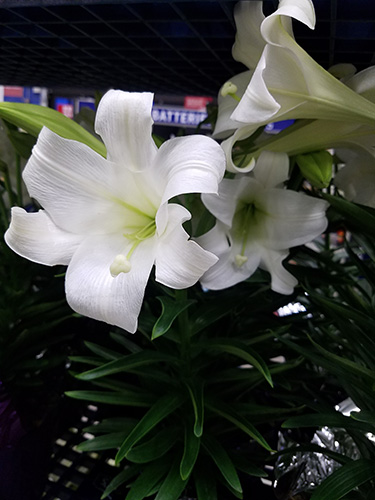 Year after year during early spring, we see flowering plants fill the stores. One of these traditional, white flowers is the Easter lily, which holds a long-standing tradition in spring as the flower seen in churches and at Easter gatherings. You’ve probably seen this beautiful trumpet-shaped flower, but do you know the flower’s history?
Year after year during early spring, we see flowering plants fill the stores. One of these traditional, white flowers is the Easter lily, which holds a long-standing tradition in spring as the flower seen in churches and at Easter gatherings. You’ve probably seen this beautiful trumpet-shaped flower, but do you know the flower’s history?
The Easter lily takes its roots back to the Ryukyu Islands in southern Japan. It was first introduced to England in 1819 and America in 1880. Lily bulb production was centered in Japan and the southern U.S. in the late 1800s and on, but in 1941 during WWII, the Japanese source was cut off. This resulted in the increased value of the lily bulb. Soon, growers in the U.S. boomed and by 1945, there were about 1,200 growers from Vancouver, Canada to Long Beach, California. This has since reduced in size, leaving only about 10 growers in a small region of the Oregon-California border. Today, the region is called the Easter Lily Capital of the World, where over 95 percent of potted Easter lily bulbs are produced.
The bulbs are harvested in fall, then packed and shipped to commercial greenhouses. In order to get the flowers to bloom for Easter, they are planted in pots and forced to bloom under controlled conditions. This can be a challenge because Easter falls on a different date each year, but commercial greenhouse growers have got it down to a science. They look for bud and leaf development timing to determine if bulbs will bloom at the correct time or not. If the plant is going to bloom too early or late, the growers can adjust the humidity and temperature of the greenhouse to achieve the desired bloom time.
Beyond its history, the Easter lily has traditional and spiritual meaning. Mentioned many times in the Bible, the white lily symbolizes purity, rebirth, new beginnings and hope and is most often associated with the resurrection of Jesus Christ as observed on Easter. In Pagan traditions, the Easter lily is associated with motherhood and is often gifted to mothers as a symbol of gratitude. Across many religions and beliefs, the white lilies are symbols of purity and grace.
Whatever the Easter lily means to you, it’s important to know how to care for one in your home if you were gifted one this spring. First, you want to remove any decorative wrapping and put the pot on a saucer to catch excess water. It is recommended to remove the anthers from the center of the flower to increase the life of the bloom and reduce staining of pollen on the white petals. You’ll want to choose a spot in your home with bright, indirect light and make sure the temperature stays around 60 to 68 degrees Fahrenheit. When the soil is dry to the touch, water the plant thoroughly. Any water that pools in the saucer should be discarded. To promote new growth, you need to remove withered flowers. The flower may often be too pungent for indoors, so once night temperatures are above 50 degrees Fahrenheit, they can be planted outside in the garden.
When you see the white Easter lily at an Easter or spring gathering, you will now have a perfect conversation starter.
Fisher, J.
2018,
The history and tradition of the Easter lily,
Reno Gazette Journal


